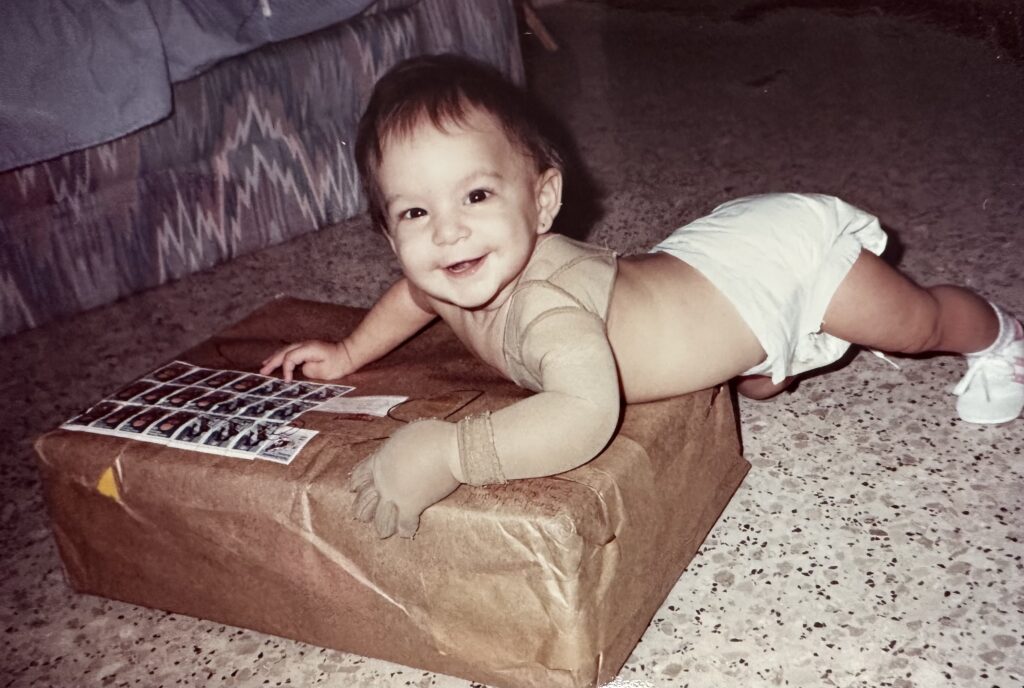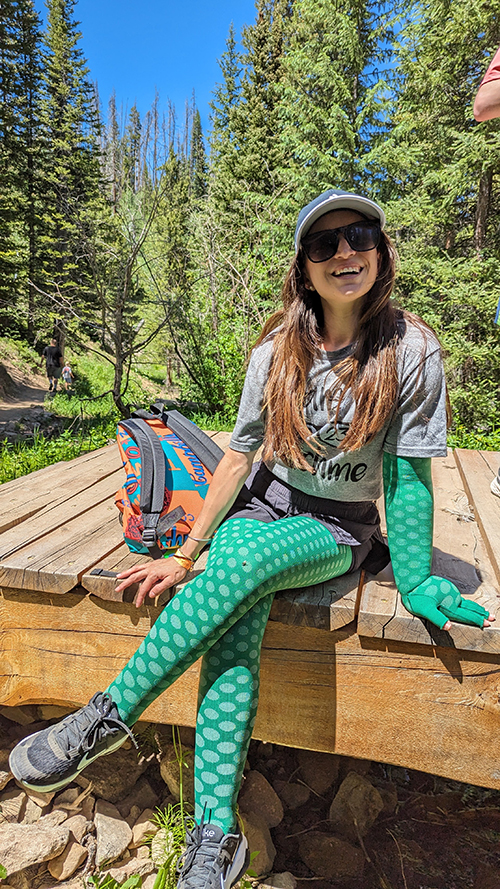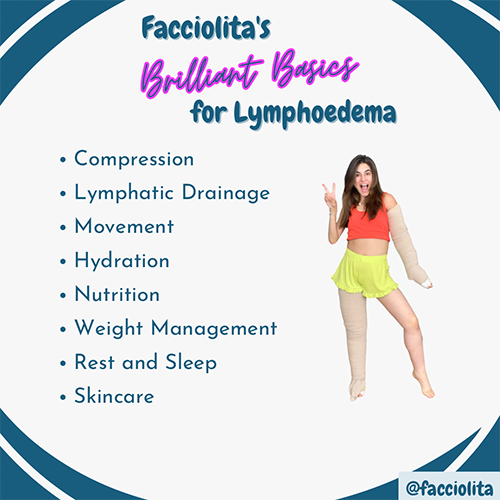“Facciolita’s Brilliant Basics” for Lymphoedema maintenance and management

“When it comes to Lymphoedema treatment and management, we all need the same things, it’s just a matter of tailoring the treatments and methodologies to each patient but the core fundamentals are the same”. This is the statement I said on my last Accelerate visit and the statement that sparked the idea for this blog.
You might wonder what makes me qualified to hold this opinion and write this article. Well, let me introduce myself first. My name is Nicole Faccio and I am a congenital primary Lymphoedema patient. My lymphoedema was present at birth in my left arm, and after a couple of months, it was also discovered in my legs, abdomen, and face. As a result of this, I have some sort of swelling in about 75% of my body.

I was born with what now is known as the WILD syndrome, which is a genetic mutation that causes malformations in my whole lymphatic and immune system. You can conclude I have quite a complex Lymphoedema pathology and a rather chronic Lymphoedema presentation in my whole body with additional complexities like a collapsed lung, genital lymphoedema, lymphangiomas, and protein-losing enteropathy, among others.
In my journey with the condition, I have visited numerous hospitals, medical facilities, and clinics, have met numerous doctors all around the world and have traveled to many places in search of solutions and answers to the list of Lymphoedema enigmas. In that process I have also met many Lymphoedema patients all around the world, many of whom are now my friends, hence what I discuss here not only reflects my perspective but has also been validated by other Lymphies1.

I am now 36 years young 😎, and like almost all Lymphoedema patients, I’ve spent most of my life (time, energy, and lots of money) treating my symptoms, often finding it unhelpful, frustrating, and discouraging. This led me to neglect caring for the condition for years, ultimately making everything worse.
Lymphoedema is moody and extremely inconsistent; it can be very demoralising, and the facts are that Lymphoedema has no cure. This is a tough realisation to face, especially when you are new to the condition. But the good news is that there is a course of treatment and management that works, and if followed, I can vouch for its effectiveness, and that is precisely what I want to discuss in this blog.
First, I’d like to concentrate on the symptoms vs source comment from before because as I mentioned, unfortunately, most people concentrate their efforts on managing only “the swelling” and its side-effects, while neglecting the root cause. Although most of the recommendations are correct and are focused on managing swelling through compression, the swelling itself isn’t the primary issue. The problem is the chronic accumulation of fluid. Therefore, the only way to achieve consistency and stability with your Lymphoedema is to nurture your lymphatic system, instead of only treating your Lymphoedema swelling. Reducing the stress and strain on your lymphatic system directly correlates with decreasing swelling and fibrosis, better skin, and fewer subsequent consequences, resulting from increased fluid accumulation in your extremities, such as wounds, infections, recurrent infections, leaking oedema, development of papillomas etc.

The following advice is what I would call “Facciolita’s Brilliant Basics” for Lymphoedema maintenance and management. These suggestions are based on my experience and the positive effect they’ve had on my own body. By consistently incorporating these lifestyle changes my Lymphoedema health has improved immensely over the last few years and has allowed me to regain my quality of life. The reality is that none of them are miraculous cures, but they are lifestyle changes that have significantly impacted my life.

Facciolita’s Brilliant Basics for Lymphoedema management
- Compression
- Movement
- Lymphatic Drainage
- Hydration
- Nutrition
- Weight Management
- Rest and Sleep
- Skincare
1. Compression
Compression is by far the most important and indisputable pillar of Lymphoedema management. It’s important to remember that our bodies don’t have the ability to put a stop to the accumulation of fluid, so we need to aid that by wearing compression externally. I often say that compression is needed ‘all day in all ways’ but I also say it without the intent of it being overwhelming. I suffered from the “overwhelming” nature of the general guidance of Lymphoedema, and I remember thinking that doctors were crazy when they told me I needed to wear compression for as close to 24 hours as possible. It is no secret that the more you wear your compression, the more stable the lymphoedema will be, but it doesn’t have to be 24 hours a day. My advice is: Find what works for you, but keep in mind that the more you wear it the better you will feel. For most individuals, wearing garments throughout the day, from morning to evening is a common practice during their active hours.
*It’s important to note that there are crucial differences between everyday compression, reduction compression, and maintenance compression, and I’ll elaborate below:
Every day compression
- Compression garments. (Ideally flat knit custom medical grade stockings meant to be used daily)
Although a hard reality of Lymphoedema is that you need to wear compression garments, I’ve chosen to focus on the positive and appreciate their presence rather than viewing them as the villain in the movie. Garments are actually our best friends. It takes time to get used to them, they are not the most glamorous articles of clothing, and during the summers they are very difficult to bear, but they do work. I refer to them now as “my second skin”, because without them, I don’t know in what state my Lymphoedema would be in.
Reduction compression
Complete decongestive therapy (CDT) with MLD and short-stretch bandages
This is the technique of combining MLD (Manual Lymphatic Drainage) massage and compression therapy with bandages, used to achieve volume reduction and fibrotic tissue softening (those hard skin areas). A complete course of CDT will usually be done by a Lymphoedema therapist in a Lymphoedema clinic, and is recommended to be done for 3 to 5 weeks, depending on your condition. The goal is to minimise swelling as much as possible, so in the end, they can take your measurements and provide you with the tightest fitting garments.
Bandaging in itself is also a very important component of lymphoedema management, typically recommended for nighttime use but not exclusively. It is important to break the fibrotic tissue to ensure that we don’t have areas blocking the lymph fluid outside the extremity. Important to note that compression garments are not a tool to achieve reduction in volume.
Maintenance compression
This refers to Self bandaging products in the market that are great for your everyday maintenance and flare-up moments, like the Circaid, Justafix, Mobidem, Autofix etc
I often use the Autofix as a replacement for the bandage. I am also a fan of the Circaid to use while traveling or even when I need extra compression on top of my garment while I’m at home. When I require additional support, I’ve become a fan of using the Comfiwave for night time compression. Although I promote self-bandaging as the ideal protocol at home, I’m also aware that, in reality, it can be time-consuming and at times daunting due to the limited information available, so I recommend any of these products as aid.
2 Movement
A lot of people talk about exercise as the main focus, but I like to say it is just about movement. Exercising suggests a more strenuous activity for only the ones fit for it, and many people can’t move in such an agile way. The important thing is to move. To stay active, even by walking at whatever pace you can. Your muscles help in the flow of accumulated fluid out of the extremities, so moving is a key element in maintaining a healthy lymphoedema.
Note: Movement is necessary while wearing COMPRESSION.*
I am often asked what type of exercise you can do with Lymphoedema. To be honest, all of them, as long as you wear your compression! I cycle, do indoor cycling, boxing, running, Pilates, swim, yoga, HIIT, you name it! Of course, I always listen to my body and monitor my swelling. Three types of exercises that I’ve found particularly helpful are Swimming, Yoga and Strength training. I’ve seen great improvements with weights training too, as long as I allow the rest days.
3 Lymphatic Drainage
Lymphatic massage or Lymphatic drainage or Lymphatic drainage massage are all versions (or should be) of their mother: Manual Lymphatic drainage. This is the massage technique designed to stimulate the lymphatic system to encourage the lymph to move. In the esthetics world, it is linked to reduced swelling, puffiness, improved gut problems, reduced severity of skin conditions etc. The truth is that the origins of the technique are medical, aiming to gently manipulate specific areas of your body to help lymph move to an area with working lymph vessels. This was developed by a doctor in Austria called Dr. Vodder, and it was developed with the whole purpose of alleviating Lymphoedema patients from the static fluid.
Manual Lymphatic Drainage, paired with compression, is extremely effective in Lymphoedema swelling reduction. If feasible, I suggest getting MLD weekly. Unfortunately, this is not possible for most of us due to the limited availability of treatment in most areas, both in terms of resources and proper medical execution.
In the absence of the professional health care treatment, there are tools in the market you can get to stimulate your Lymphatic System such as the Guasha andDry Brushes, however learning the Self MLD techniques only requires the use of your hands to achieve effective lymphatic drainage
CAUTION: Lymphatic drainage has been massively commercialised in recent years, and a lot of people offer the treatment in spas for estetique benefits but they are not medically trained to treat lymphoedema patients. Also important to acknowledge that some patients don’t see much benefits from MLD, especially when done alone without compression.
4 Hydration
Hydration is probably the most overlooked topic here, and extremely essential for your lymphatic health, and therefore your lymphedema. Hydration is key to limit lymphatic congestion and to aid that immune system the lymphatic system is part of. I try to drink the closest to 2 – 3 liters of water a day. Good hydration is also linked to many other health benefits including skin and gut health which will be likely affected by your lymphedema too.Stay hydrated!
5 Nutrition
People say that food is medicine, and that is no different for lymphoedema patients. I’m not here to suggest any miraculous diets, nor do I believe in magical cleanses. I believe in a good, balanced, nutritional diet that enables your lymphatic health. I consume anything that supports the optimal function of my lymphatic system, and limit anything that can cause extra inflammation. Some of my basic recommendations are:
- What to limit: Foods rich in salt. Although you still need to consume sodium because it is a key chemical needed in your body you should refrain from eating inflammatory foods such as fried food, anything with high processed sugars (e.g. cookies, cakes, pastries, sodas and artificially sweetened drinks), processed fatty meats (e.g. hot dogs, bacon) and monitor your consumption of refined grains such as wheat.
- What to consume more of: Natural fruits, especially berries as they have great antioxidant properties and benefits on gut health. Vegetables, primordially greens.Leaner meats (this can be red meat), legumes, unrefined grains such as quinoa and black rice, pickled foods, and all the good proteins like eggs (I am aware that some people say that eggs can be linked to joint inflammation, but I am giving lymphatic health guidance here )
- Coffee: There is conflicting guidance on caffeine, with some believing it leads to inflammation. There is another school of thought that believes the opposite. I have never experienced any issues with coffee and my Lymphoedema so I don’t necessarily think it is an issue
- Alcohol: Unlike coffee, alcohol is an issue for Lymphoedema. Of course, anything in excess is problematic, and I am not one to deprive myself of a good wine, but there is no secret that limiting alcohol will have a significant positive impact on your lymphedema. Alcohol is an inflammatory agent and promotes the accumulation of fluid.
6 Weight Management
It is proven that weight gain has a direct impact on the health of the lymphatic system and therefore if you have lymphoedema it is linked to more swelling. There is also proven research linking obesity with developing lymphoedema because of the impact on the lymphatic system, which means that anyone who experiences significant weight gain is at risk of developing lymphatic problems, and therefore lymphoedema. I strive to maintain my weight closest to the healthy limits because I can say firsthand that when I’ve gained weight, I’ve seen the impact on my swelling. Maintaining good nutrition is key to maintaining a good weight.
7 Rest and Sleep
Rest and good sleep are associated with overall better health in general, and that is no different for your lymphatic system and lymphoedema either. The laws of gravity will always have an impact on our lymphoedema by nature and excessive strenuous activity will have a greater impact on a person with a compromised lymphatic system. My recommendation is to prioritise rest periods and sleep because I’ve seen the dramatic impact on my swelling. My worst habit is my sleeping pattern. I’ve struggled for a while with having a consistent schedule, but when I get a good 7/8 hours of sleep, my Lymphoedema is super grateful for it. In fact, I now prioritise a good night’s sleep over compression at night if I feel the compression is going to affect the quality of my sleep.
8 Skin care
Last but certainly not least, skin care is extremely important for lymphoedema patients. The accumulation of fluid and swelling have a big impact on your skin, increasing the risk of infections and wounds, therefore it requires extra care and more hydration. My secret formula is to use oil after bathing to maintain my skin in good shape. I also use a low alcohol content hydrating cream as a night-time routine and before bandaging. It is also key to ensure adequate hydration in those areas prone to scaling. It’s also crucial to thoroughly dry creasing areas such as between toes to avoid the accumulation of extra humidity that can cause fungus and therefore an infection.
I hope that the above can at least provide people with some reassurance that the basic principles do work if applied. I also believe the medical field spends a lot of time in reactive measures towards Lymphoedema complications, such as wounds and infections, and we don’t spend enough time in promoting a healthy lifestyle to prevent them, which as you can see, doesn’t really constitute a complex guidance. If you want to know more about my Lymphoedema journey and my life with Lymphoedema while following the Brilliant Basics, you can follow me on social media as @facciolita on Instagram and TikTok. Write me a message or comment, happy to answer any questions and help the community as much as I can. Hopefully, you can also hop on the trend of wearing your compression proudly and get comfort in the fact you are not alone.
Thanks for reading!
Lots of Lymphie Love,
Nicole Faccio ❤️
